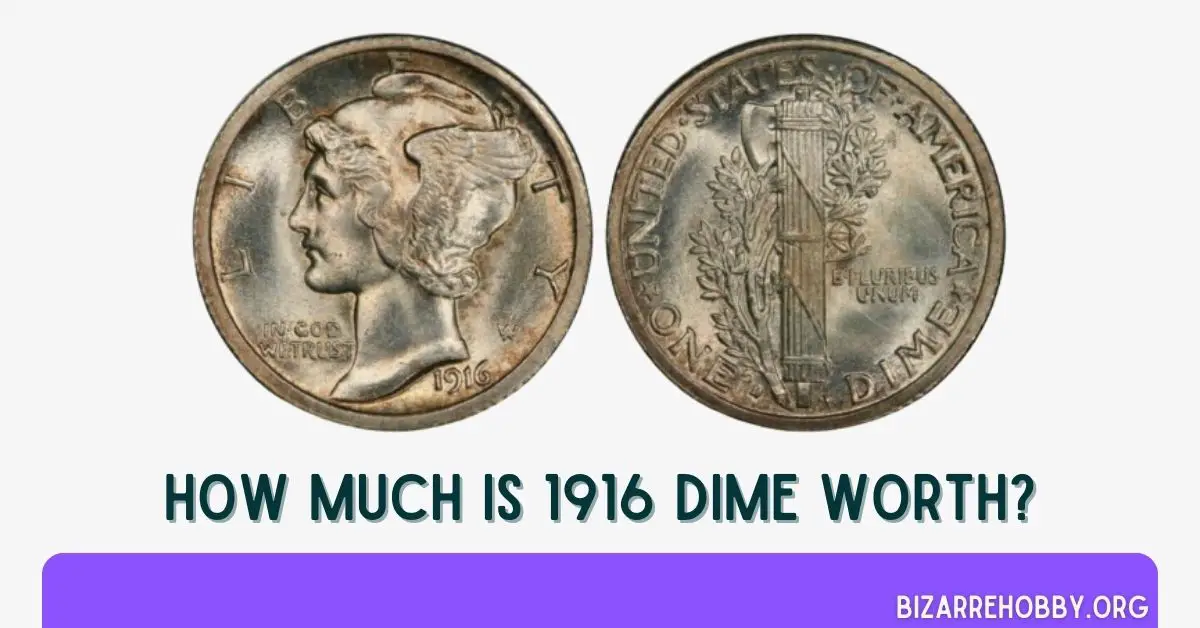The 1916 dime holds a special place in American numismatics, marking a transition in coinage design and minting practices. This year saw the circulation of two distinct dimes: the long-standing Barber Dime and the newly introduced Mercury Dime.
Let’s explore the rich history and value of these coins, exploring their unique features, errors, and mint marks.
Table of Contents
Value Charts for 1916 Dime
| Coin | VF 25 | AU 50 | MS 60 | MS 65 | MS 67+ | MS 68+ |
|---|---|---|---|---|---|---|
| 1916 No Mint Mark Barber Dime | $27 | $75 | $210 | $465 | $4,000 | NA |
| 1916-S Barber Dime | $27 | $75 | $210 | $600 | $14,000 | NA |
| 1916 No Mint Mark Mercury Dime | $12 | $25 | $60 | $180 | $1,650 | NA |
| 1916 No Mint Mark Mercury Dime Full Bands | NA | NA | $65 | $375 | $2,450 | $25,000 |
| 1916-D Mercury Dime | $5,750 | $10,250 | $15,000 | $33,500 | NA | NA |
| 1916-D Mercury Dime Full Bands | NA | $10,500 | $18,500 | $60,000 | $285,000 | NA |
| 1916-S Mercury Dime | $25 | $40 | $65 | $335 | $6,250 | NA |
| 1916-S Mercury Dime Full Bands | NA | NA | $100 | $1,025 | $14,500 | NA |
Historical Significance of the 1916 Dime
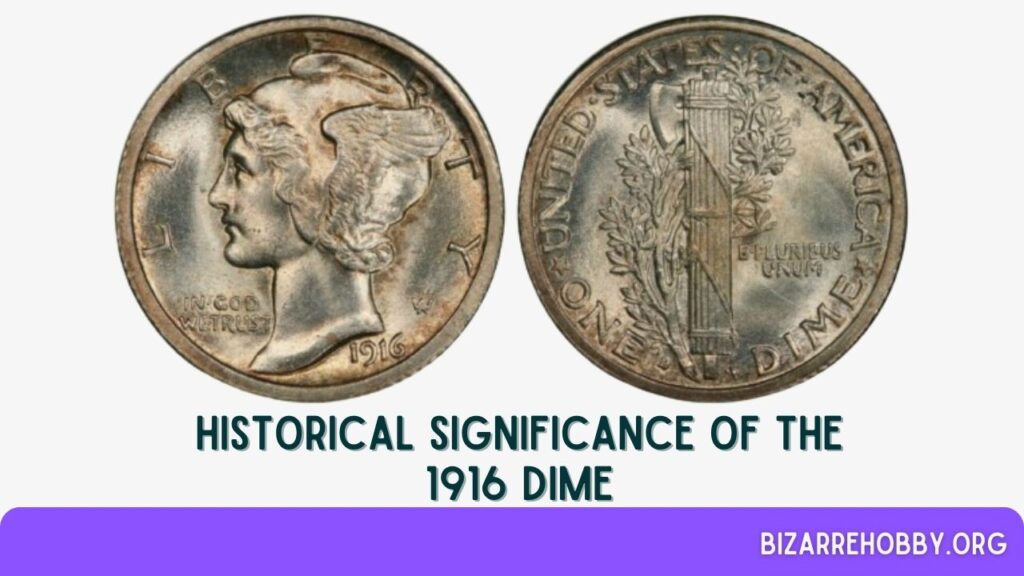
The dime, deriving its name from the Old French word meaning “tenth” or “tithe,” has long been a pivotal denomination in U.S. currency. Historically, it served as a dividing line:
- Coins above the dime were made of precious metals
- Denominations below were crafted from base metals
- Dimes and higher-value coins featured reeded edges to prevent fraud
- Lower denominations lacked reeding due to their composition
This demarcation extended to design elements as well. While higher denominations proudly displayed eagles on their reverse, dimes and lower-value coins featured alternative imagery.
1916 was a landmark year for the dime, witnessing the coexistence of two distinct designs:
- The Barber Dime: Designed by Charles Barber, Chief Mint Engraver
- The Mercury Dime: A new design by Adolph Weinman
The Mercury Dime: A Design Revolution
The Mercury Dime, despite its misleading nickname, actually depicted Lady Liberty wearing a winged Phrygian cap. This design was part of President Theodore Roosevelt’s ambitious coin beautification project, initiated in 1904 and continued by his successor, William Howard Taft.
Key features of the Mercury Dime:
- Designed by Adolph Weinman, who won a competitive selection process
- Often mistaken for the Roman god Mercury due to the winged cap
- Sometimes called the “golf dime” or “battle axe dime” due to misinterpretation of the fasces on the reverse
The Lingering Barber Dime
Charles Barber, reluctant to see his design phased out, created production delays for the new Mercury Dime. As a result, the Barber Dime continued to be minted in 1916 to meet circulation needs. This dime shared its obverse portrait with the Barber Quarter and Half Dollar.
The 1916 Dime in Context
The introduction of the Mercury Dime was part of a larger movement in American coinage:
- It fulfilled Theodore Roosevelt’s vision for more artistic U.S. coins
- The design was created alongside other new coins by sculptors linked to Augustus Saint-Gaudens
- These new designs collectively replaced the Barber Coinage series
Understanding the historical context and design elements of the 1916 dime is crucial for collectors and enthusiasts alike.
Design of the 1916 Dime
The 1916 dime stands out in numismatic history as a year of transition, featuring both the new Mercury Dime and the outgoing Barber Dime. Let’s explore the features of both designs, breaking down their obverse, reverse, and technical specifications.
Obverse Design of 1916 Mercury Dime
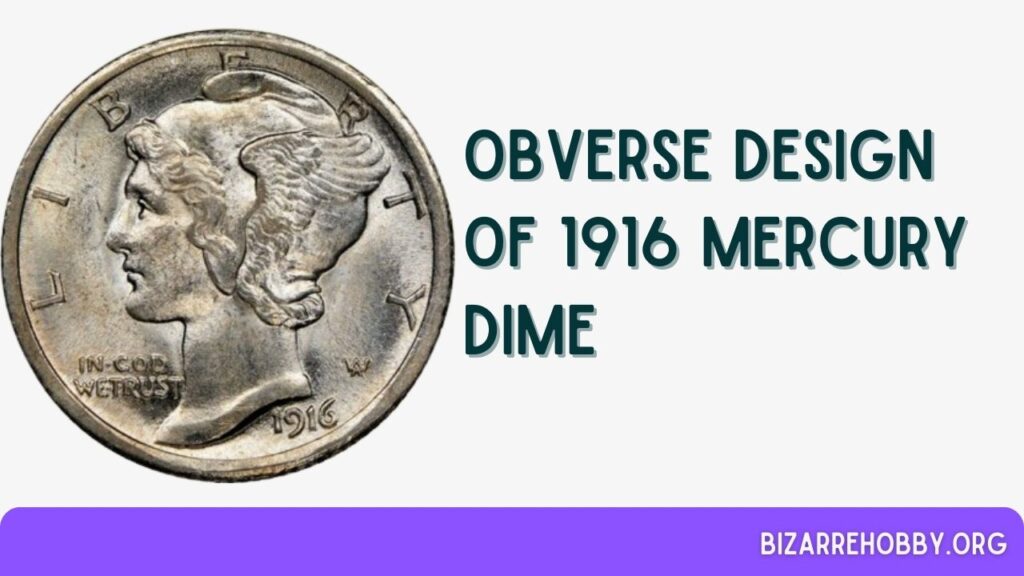
- Central Device: Miss Liberty wearing a winged Phrygian cap
- Legend: “LIBERTY” curving around the top
- Motto: “IN GOD WE TRUST” beneath Liberty’s chin
- Designer’s Mark: Stylized “AW” for Adolph Weinman behind Liberty
- Date: Located in the lower right
Reverse Design of 1916 Mercury Dime
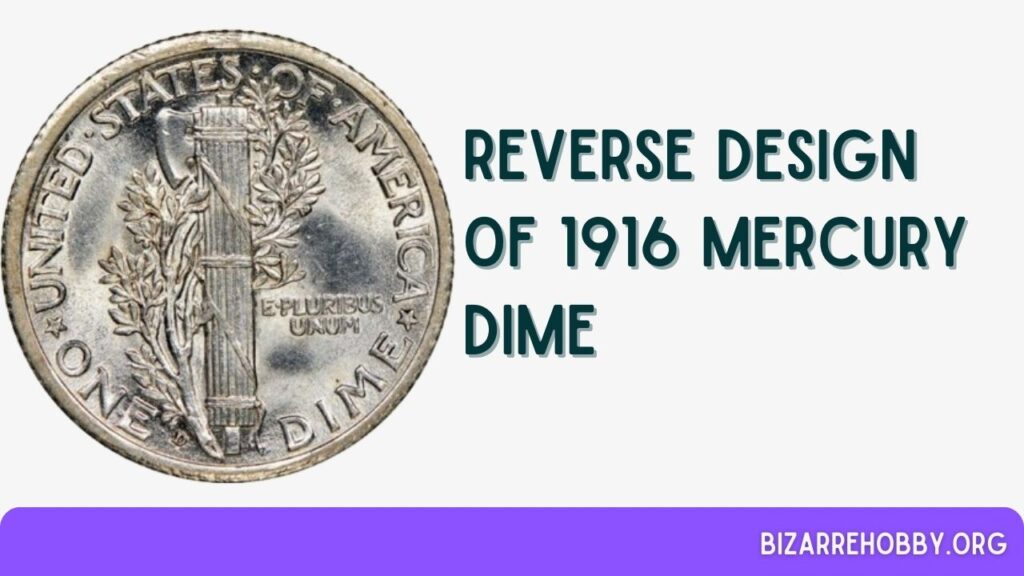
- Central Device: Fasces (battle axe bound with rods) wrapped with an olive branch
- Legends: “UNITED STATES OF AMERICA” at the top and “ONE DIME” at the bottom.
- Motto: “E PLURIBUS UNUM” on the right
- Mint Mark: Located after “ONE” (if present)
- Design Elements: Two stars separating the legends
Technical Specifications of 1916 Mercury Dime
- Composition: 90% Silver, 10% Copper
- Diameter: 17.91mm (0.705 inches)
- Thickness: 1.35mm (0.053 inches)
- Weight: 2.5 grams
- Edge: 118 reeds
Obverse Design of 1916 Barber Penny
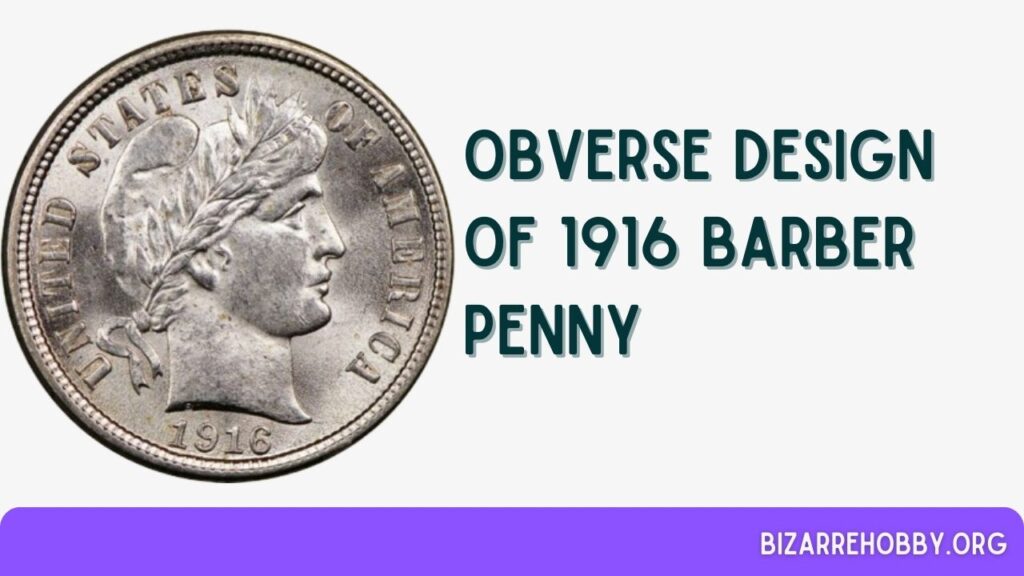
- Central Device: Lady Liberty facing right, wearing:
- Phrygian cap
- Olive wreath
- Headband inscribed with “LIBERTY“
- Legends:
- “UNITED STATES” behind Liberty’s head
- “OF AMERICA” in front
- Date: At the bottom of the coin
Reverse Design of 1916 Barber Dime

- Central Device: Wreath composed of wheat, oak, corn, and cotton leaves
- Denomination: “ONE DIME” inside the wreath
- Mint Mark: Below the ribbon tying the wreath (if present)
Technical Specifications of 1916 Barber Dime
Identical to the Mercury Dime:
- 90% Silver, 10% Copper
- 17.91mm diameter
- 1.35mm thickness
- 2.5 grams weight
- 118 reeds on the edge
Key Differences and Collector Notes
The Mercury Dime, despite its nickname, actually depicts Liberty, not the Roman god Mercury. The Barber Dime’s cotton leaves are often mistaken for maple leaves due to their similar appearance. No proof coins were minted for the 1916 Barber Dime. The 1916 Mercury Dime marked the first year of a new design, replacing the unpopular Barber Dime.
Grading Guide for 1916 Dime
Dimes, like other coins, are graded on the Sheldon Scale, which ranges from 1 to 70. However, Mercury Dimes have an additional quality marker based on their reverse design.
These coins may be labeled as FB, indicating Full Bands, which assesses the clarity of the bands tying the sticks and axe. For Roosevelt Dimes, a similar descriptor is used, but the NGC refers to it as FT for Full Torch.
| Sheldon Scale | Grade |
|---|---|
| 1 | Basal State-1 |
| 2 | Fair |
| 3 | Very Fair |
| 4, 5, 6 | Good |
| 7, 8, 10 | Very Good |
| 12, 15 | Fine |
| 20, 30 | Very Fine |
| 40 | Extremely Fine |
| 50 | About Uncirculated |
| 60 | Mint State |
| 65 | Mint State |
| 70 | Mint State |
For a detailed understanding of your coin’s grade, please refer to our comprehensive grading guide for Barber Dimes. Knowing the exact grade is crucial for determining the precise value of your coin.
1916 Dime Value Guides
In 1916, two distinct types of dimes were minted: Barber Dimes and Mercury Dimes. The Mercury Dimes were produced in Philadelphia, San Francisco, and Denver, while the Barber Dimes were minted only in Philadelphia and San Francisco.
None of these coins were proofs; they were all regular strikes intended for everyday transactions. Let’s delve into their current market values.
1916 No Mint Mark Mercury Dime Value
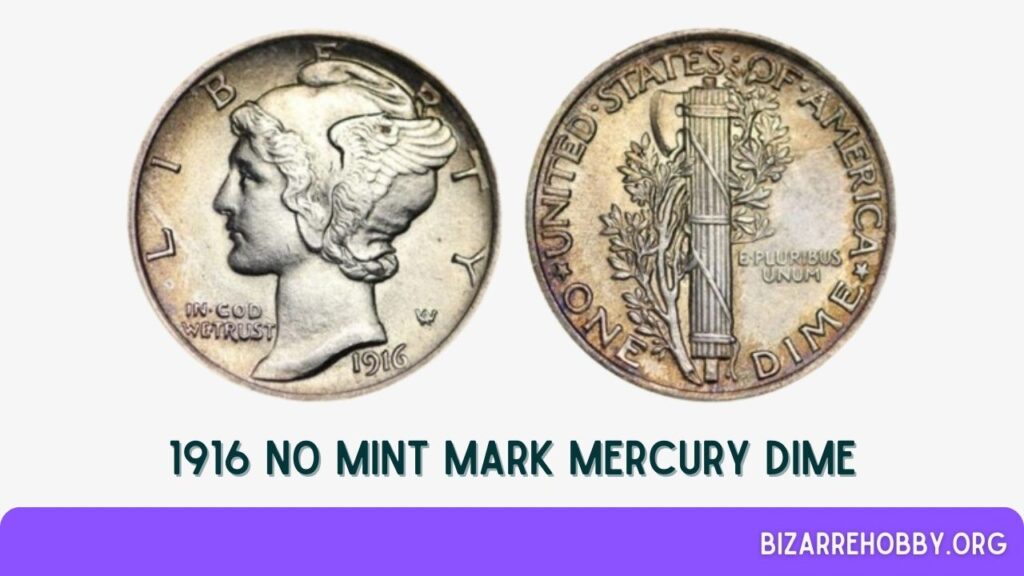
In 1916, the Philadelphia Mint produced 22,180,080 Mercury Dimes without mint marks. An NGC-graded MS 67+ sold for $1,998 in November 2013. As of October 2023, a PCGS MS 67 is valued at $1,175. In August 2020, an MS 68+ FB fetched $20,400 at auction, and this grade is now estimated to be worth $25,000.
1916-D Mercury Dime Value
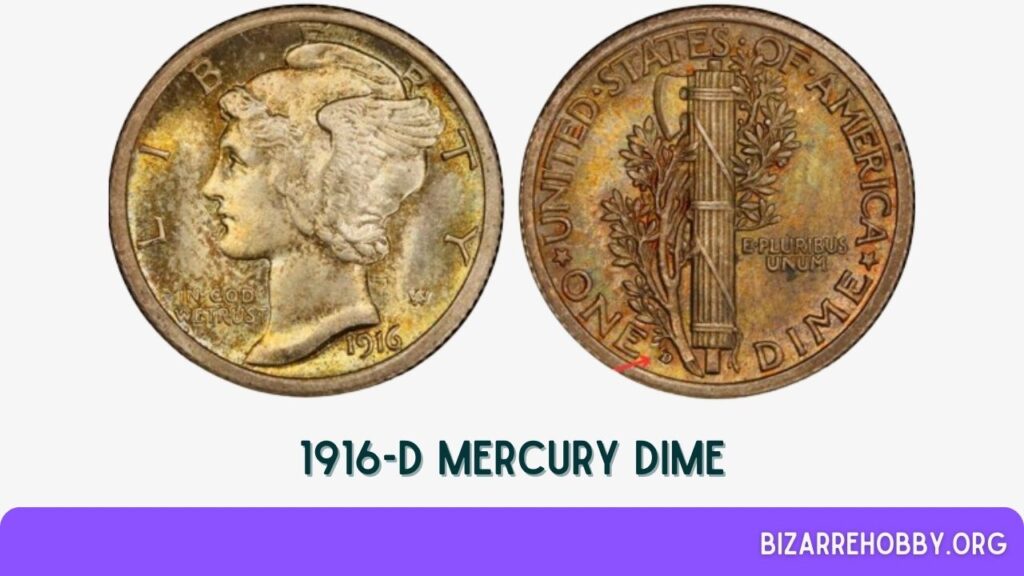
The Denver Mint struck 264,000 Mercury Dimes with the “D” mint mark in 1916. Due to their low mintage, an MS 65 sold for $29,900 in August 2007. Currently, seven such coins exist, valued at $33,500.
The highest grade, MS 66, is worth $50,000. An MS 67 FB sold for $207,000 in August 2010 and is now valued at $235,000. An MS 67+ FB is estimated at $285,000.
1916-S Mercury Dime Value
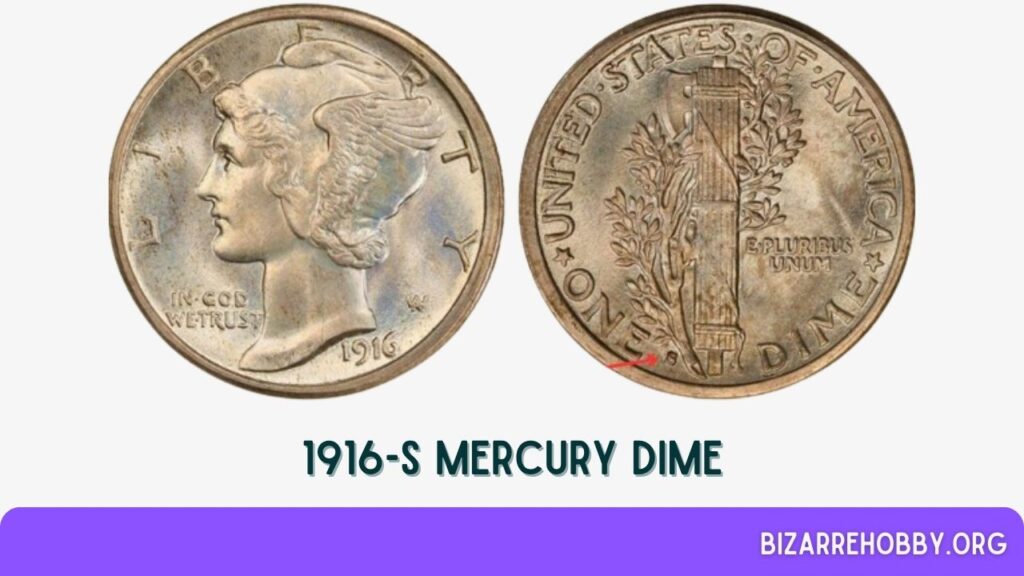
The San Francisco Mint produced 10,450,000 Mercury Dimes in 1916 with the “S” mint mark. An MS 67+ sold for $4,406 in March 2013, and this grade is now valued at $6,250. For Full Bands Dimes, an MS 67 FB was valued at $23,000 in August 2001 but is now worth $4,500. Two MS 67+ FBs are currently valued at $15,000.
1916 No Mint Mark Barber Dime Value
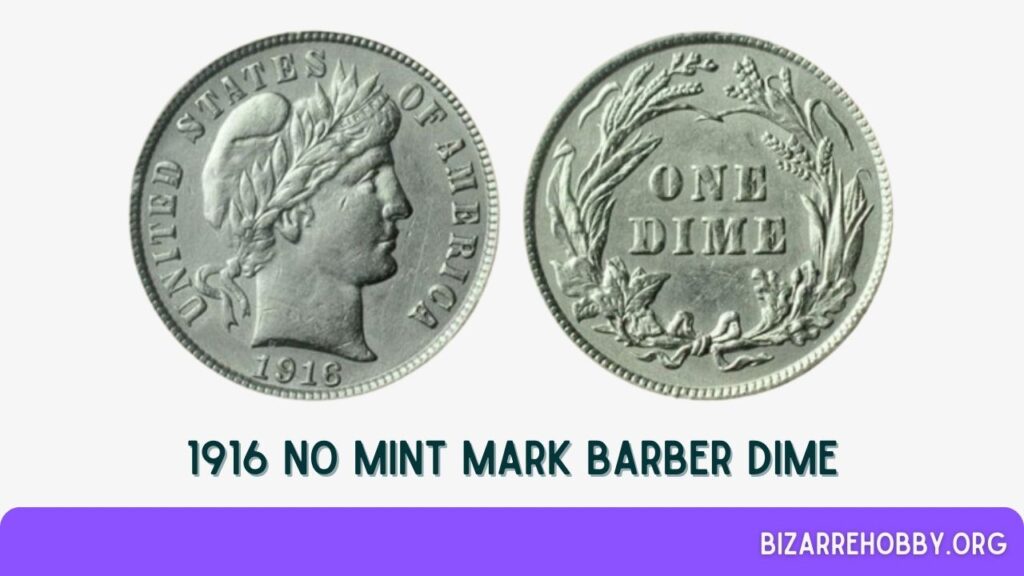
In 1916, the Philadelphia Mint produced 18,490,000 Barber Dimes without mint marks. These coins are over a century old, making them true antiques. A VF 25 grade sold for $46,000 on September 21, 2005. Today, a VF 25 is worth $27, while the highest known grade, MS 67+, is valued at $4,000.
1916-S Barber Dime Value
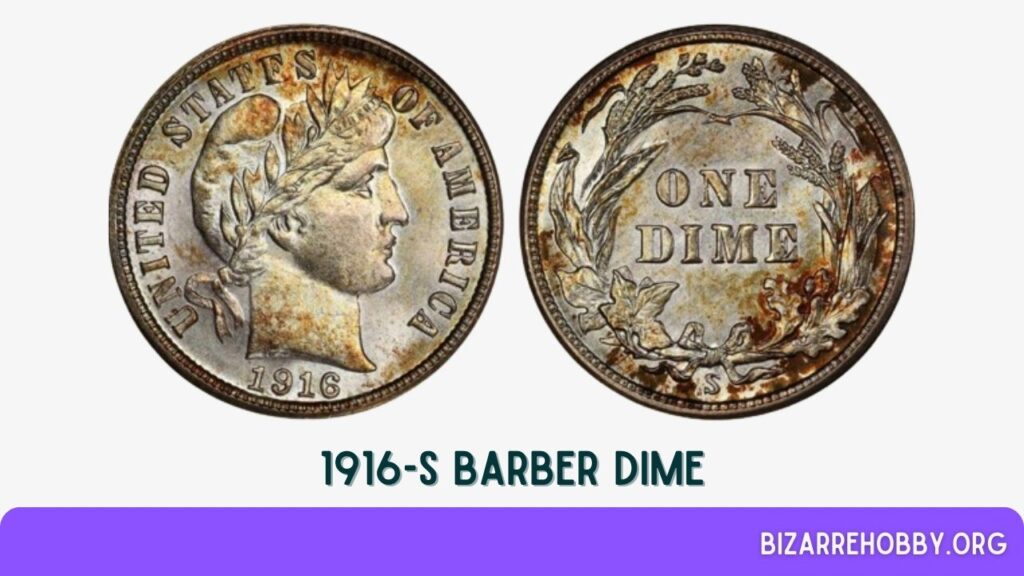
The San Francisco Mint produced 5,820,000 Barber Dimes in 1916, all with the “S” mint mark. An MS 67 sold for $7,250 on December 2, 2018, and is now valued at $7,750, with only three known coins. PCGS has graded one MS 67+ at $14,000 as of October 2023. An MS 65 is valued at $600, and an MS 60 is worth $210 in 2023.
Rare 1916 Dime Error List
Numismatists, who specialize in studying, trading, and collecting coins, paper money, medals, and tokens, find error coins particularly fascinating due to their increased value compared to flawless coins.
Errors identified within 30 days of a coin’s release are termed FS Errors (First-Strike Errors), but even later errors can be quite valuable. Let’s explore some notable 1916 Dime Errors.
1916-S and 1916 [P] Barber Dime Broad-struck Error
A broadstrike occurs when the retaining collar of a coin is flattened and widened. This collar ensures coins maintain consistent width, thickness, and metal volume, aiding in their stacking.
Older coins used a three-piece detachable collar mold for this purpose. An AU 58 graded broadstruck Barber Dime was valued at $400, while an MS 65 was priced at $575.
1916-D Mercury Dime Broad-struck Error
For newer coins, retaining collars are created using an upsetting machine that squeezes blanks through narrow gaps to raise the rim. However, the 1916-D Mercury Dime used the older three-piece collar molding technique.
This resulted in a wider, shorter collar that extended towards the inner coin field, making it flatter and thicker. An XF 45 graded example sold for $6,900.
1916-S Barber Dime Struck 10% Off-Center Error
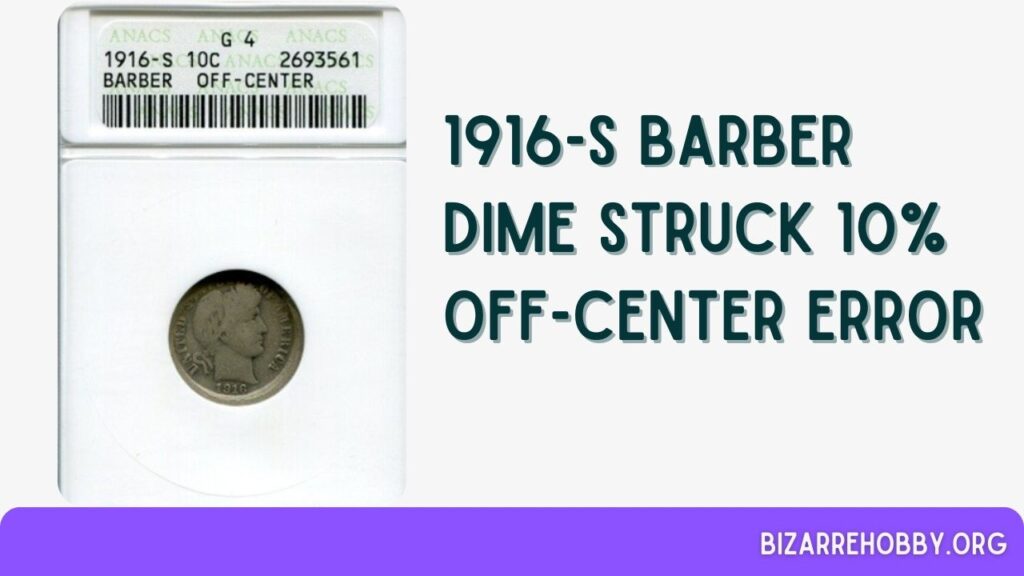
At first glance, this might appear to be another broadstrike, but it’s actually a different mint error caused by the planchet not being correctly positioned between the dies.
This misalignment leaves part of the coin’s surface unmarked. The error is described by the percentage of the unmarked area. An AU 58 graded 10% Off-Center Barber Dime sold for approximately $660.
1916-S Mercury Dime Uncentered Blank Error
This error, referred to as an uncentered blank or planchet, occurs when the feeder fingers misposition the blank between the dies, resulting in unmarked spots on the lower obverse and upper reverse. Although the percentage of the error isn’t listed, an AU 50 graded example sold for $340.
1916-S Barber Dime Struck Thru Error
A struck through error happens when a foreign object slips between the die and the blank during the striking process, leaving traces of its presence. On this coin, the object blocked part of the ‘O’ in ‘Of’ at the top. An XF 45 graded example sold for $110.
Where to Sell Your 1916 Dime?
Now that you have a good understanding of your 1916 Dime’s value, you might be wondering where to sell it online. I have compiled a list of some of the best platforms, along with their pros and cons.
What to look for in the 1916 Dime?
When evaluating a 1916 Dime, there are several key factors to consider to determine its value and authenticity:
- Mint Mark: Check the reverse side of the coin for the mint mark. For Mercury Dimes, it will be located after the ‘E’ in ‘One’, and for Barber Dimes, it will be under the ribbon tying the wreath. The presence and type of mint mark (D, S, or none) can significantly affect the coin’s value.
- Condition and Grade: The coin’s condition, graded on the Sheldon Scale from 1 to 70, is crucial. Higher grades, such as MS (Mint State) or AU (About Uncirculated), indicate better preservation and higher value. Look for coins with minimal wear and clear details.
- Full Bands (FB) or Full Torch (FT): For Mercury Dimes, the clarity of the bands on the fasces (a bundle of rods) on the reverse side is important. Coins with fully visible bands are more valuable. This is similar to the Full Torch designation for Roosevelt Dimes.
- Errors and Varieties: Error coins, such as those with broadstrikes, off-center strikes, or struck-through errors, can be more valuable than regular coins. Identifying these errors can significantly increase the coin’s worth.
- Historical Context: Understanding the historical context and rarity of the coin, such as the low mintage of the 1916-D Mercury Dime, can provide insights into its value. Coins from this year are over a century old, adding to their collectible appeal.
FAQs On 1916 Dime
Who is on the 1916 Dime?
Both versions of the 1916 Dime feature Lady Liberty, each with a distinctive design. The 1916 Barber Dime depicts her facing right, adorned with an olive wreath and a Liberty headband. In contrast, the 1916 Mercury Dime shows her looking left, with detailed wings on her Phrygian cap.
Where is the Mint Mark on a 1916 Dime?
The mint mark on both the Barber and Mercury Dimes is located at the bottom of the reverse side. On the 1916 Mercury Dime, it appears after the ‘E’ in ‘One’. For the Barber Dime, the mint mark is situated under the ribbon that ties the wreath.
Final Thoughts
The 1916 Dime, whether a Barber or Mercury type, holds significant historical and numismatic value. By understanding the key factors that influence its worth, such as mint marks, condition, and potential errors, collectors can make informed decisions.
Whether you’re looking to buy, sell, or simply appreciate these 1916 dimes, a thorough evaluation is essential. Remember, each coin tells a story of its time, and owning a piece of this history is truly special.
